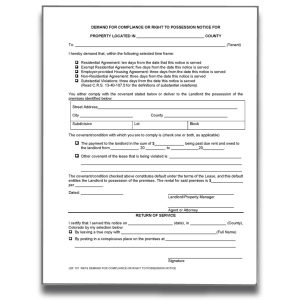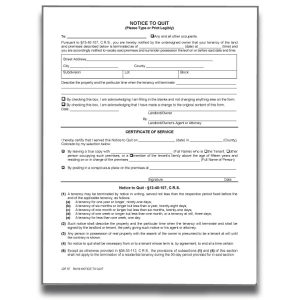Colorado Eviction Process
The following describes the process for evicting a tenant in Colorado known as a Forcible Entry and Detainer Action. This information applies to residential rental property. It does not discuss evictions from commercial or agricultural property or those related to foreclosure proceedings.
1. Complete the proper notice. Depending on the circumstances, there are two types of notices a landlord can use to begin the eviction process. The following are a list of the types of notices:
- Colorado 10 Day Notice to Pay or Quit (For failure to pay rent or other lease violations)
- Colorado Notice to Quit (For tenancy-at-will or month-to-month agreements)
2. Serve the tenant and wait. A landlord may deliver the notice personally to the tenant at their residence or place of business. A landlord may also post it in a very conspicuous area where any reasonable person would discover it such as the front door (a copy should then also be sent by certified mail). Another option is to present the notice to an adult at the dwelling unit (a copy should then also be sent by certified mail).
Note: A landlord must allow an extra day if notice is not personally delivered to the tenant.
3. Lawsuit is filed. If the tenant fails to respond to the notice to quit the landlord may file an action with the Colorado county court where the rental property is located. The following free court forms will need to be filed along with the current required filing fee (usually a few hundred dollars):
4. Serve the tenant with notice of the lawsuit. The landlord must hire a process server to physically serve the tenant with a copy of the complaint and summons at least 7 days before the scheduled court date.
5. Wait for the tenant to answer. The tenant has to respond before the scheduled court date if they were served in person and wish to dispute the landlord’s claims. The tenant may respond using this Answer Form.
5. Ask for a default judgment. If the tenant fails to answer the court, the landlord may ask the judge for a default judgment for possession to be awarded. However, if the tenant does respond and disputes the claims made by the landlord, the judge will schedule a trial to hear from both sides. The following forms made by used by a landlord when seeking a default judgment:
6. File a Writ of Restitution.If the tenant is ordered to be evicted and has not moved within 48 hours after the judgment for possession, the landlord may file a Writ of Restitution to have the sheriff escort the tenant off the property.
Notice to Quit
A 10 Day Notice to Cure or Quit notifies a tenant that if they fail to pay rent or cure other lease violations within 10 days, the landlord may file an eviction lawsuit. C.R.S. 13-40-104(1)(d)
A Notice to Quit may be used by a landlord for a tenancy-at-will or month-to-month agreement. The notice terminates tenancy with advance notice to allow time to vacate. § 13-40-107

